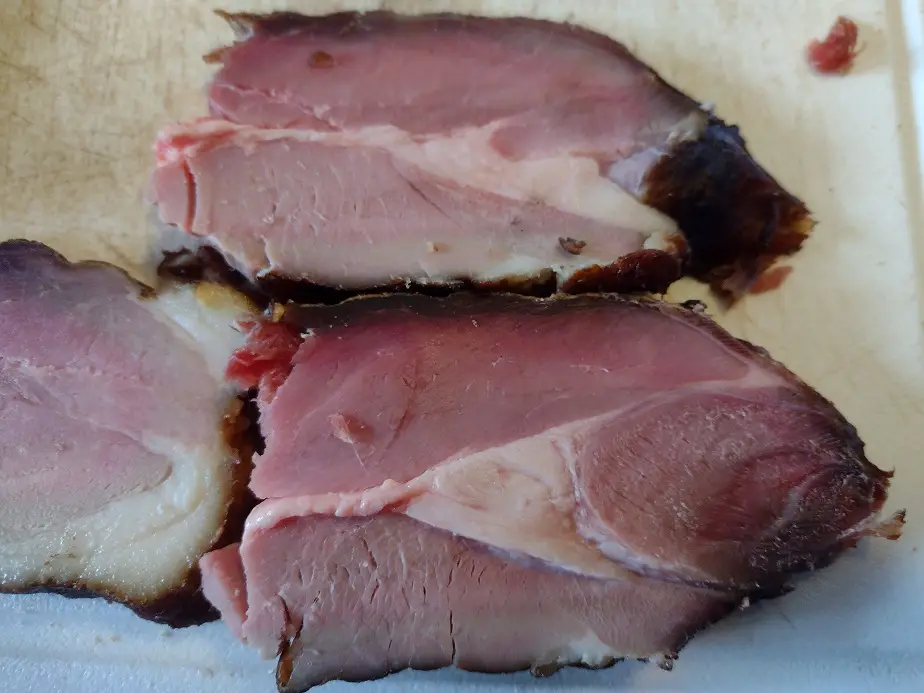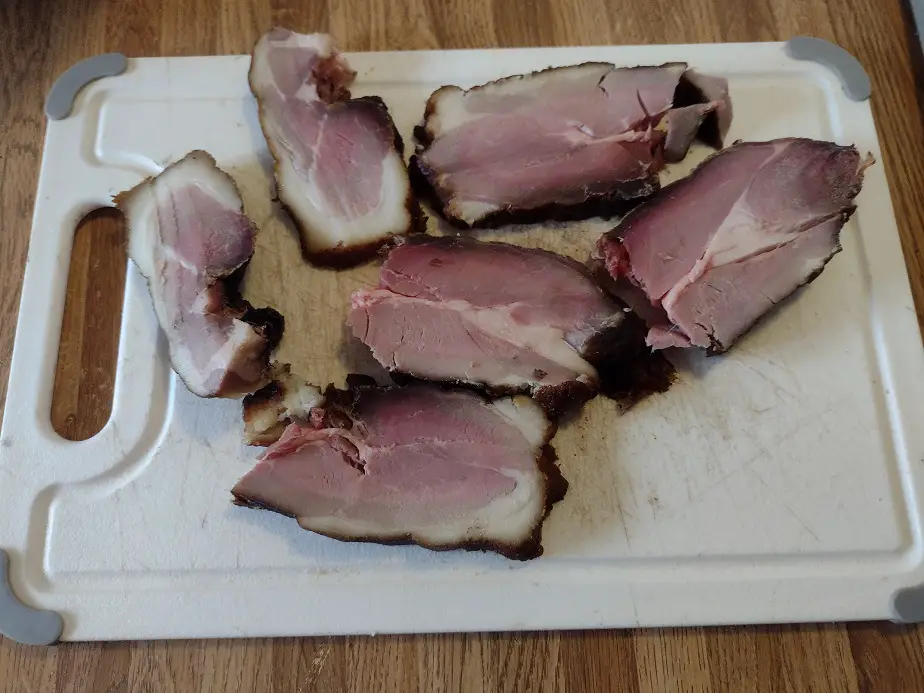I’ve started curing our own hams with nothing more than table salt and a little smoke. Once they’re cured, they don’t have to be refrigerated.
You can read about the process below, or watch the video here.
Meat can be preserved (made shelf stable) either wet or dry. Raw or cooked, it doesn’t matter. Here are the methods.
How to Salt-Cure a Ham
- Rinse and towel dry the meat
- Weigh the meat
- Weigh out salt
- Rub all the salt on the pork
- Cure by hanging or placing salted pork in the refrigerator for 3 days per pound of meat
- Cold Smoke for flavor and preservation (optional)
- Dry age for 30-90 days between 33 and 45 degrees
- Test moisture content for shelf-stability
Common Curing Mixtures
- Iodine-Free salt at 5 percent of meat weight (2 tablespoons per pound).
- 2 parts salt, 1 part sugar at 1-1/4 ounces per pound of meat (about 7.5 percent of meat weight).
I have found that a little sugar makes the ham tastier. I think I prefer it with the sugar. When I use the sweet curing mix, I go a little heavier on it just to be safe. Salt is a stronger curing agent than sugar. Adding sugar weakens the curing mix a bit, so a little heavier makes sense.
Most older recipes were way heavy on the salt; either burying meat in salt or coating it as thickly as possible. Traditionally, more salt was used in warm weather curing to do it quickly before spoilage. There’s an endless amount of variation in old methods. Here’s my take on it.
If you really just want to do it the old-fashioned way, you can. I prefer to weigh out the salt so I don’t get such a ridiculous amount on the meat.

How to Cure a Ham
There are really two major parts to creating a classic salted ham. First is the curing. In the curing process, you make it shelf-stable. Next is aging. This is how a ham gets its unique flavor and texture. Aging takes an otherwise simple salted pork and makes it softer, more tender, and well, ham-like.
In aging, we get a breakdown of meat with enzymes and beneficial Lacobaccilious bacteria. Some meat experts consider it to technically be a fermentation. Proteins in the meat will slowly break down, tenderize, and sweeten.
Here’s a few tips: Small, boneless pieces cure better and faster. You need the meat cold while it cures, think refrigerator temperatures. If it’s much warmer than 40 degrees, consider dehydrating with heat.
After the curing time, it’s recommended to keep the ham below 46 degrees. But, when properly cured, most people just hang it in their basement at probably closer to a 60-degree room temperature. That’s normal procedure.
This curing process is traditionally done in winter or fall, when the air temperature is like a refrigerator. What you don’t want is freezing temperatures. The curing process halts when frozen. If you are curing the meat and it freezes, the frozen days don’t count.
A lot of times hams, and other meats, were salted and put up to cure then left there for several months. The curing and aging processes being combined. That works fine.
Your salted meat will drip a lot of juice as moisture is pulled out by the salt. It’s best practice to hang the meat up or place it on a wire rack so the juices can drip down. I recomend setting it directly on a refrigerator wore rack and placing a dish containing a towel under the shelf to catch drips.
One more tip: When applying the salt, go a little heavier around the bone. Rub some salt into the crevasses along the ham bone to help it penetrate. That’s the hardest part of the meat to get properly cured.
Now, a classic cured ham is completely raw and completely safe to eat. You can cook it after aging if you want but it’s not needed. I usually do because a hot meal is better than a cold one.
How Much Salt is Enough?
The modern salt-curing recipes usually use about 1/2 to 1 ounce of salt per pound of meat. Some home recipes use up to 2 ounces per pound of meat, but it’s actually hard to put that much salt on. It falls off when applied too heavily.
The old, traditional recipes used as much salt as one could heap up. Some recipes actually use a wet brine. The common way its strength was measured was to put the meat in a barrel of water and add salt until the meat floated in the brine. Then it could be dried in a cool environment.
A dry, salt cure works much better for making a shelf-stable product.

How Do You Know if it’s Shelf-Stable?
When a properly salted ham has lost 35 percent of its original weight, it’s considered shelf-stable. Weigh the meat before salting. Write down the weight of the meat and the weight of salt somewhere you won’t forget. When you think it’s done, weigh it again and deduct the weight of salt you used.
A simple way to figure it is that each pound of fresh meat should lose 5-1/2 ounces of water weight. These hams, when properly cured, are usually kept for at least 3 to 6 months. In Italy, it’s common to keep a ham for several years to allow it a deep-aging. Apparently, it’s fancy that way.
What Type of Salt to Cure a Ham
Any common salt can work to cure meat. Salt that contains iodine works but leaves a funky taste. I prefer an iodine-free, sometimes called Free-Running or Pure, table salt. Check the label. Most grocery stores will have it on the shelf. It’s really cheap too.
Most curing recipes will call for kosher salt. I won’t use it. It’s incredibly expensive and cheap salt actually works just as good. Potash, also called nitrates, nitrites, or curing salts, are often used but not necessary. It’s usuall added to salt but it really doesn’t do much other than make ham pink.
Without the potash (curing salts) large hunks of meat with only salt turn grey instead of the common pink color you see in hams today. If I add nitrite to some the pork, it’ll stay pink. The color just makes it look more appealing to the average customer. Smoking the meat will also make it take on a nice pink hue.
Sugar actually works similarly to salt, but instead of sucking out water, it displaces water in meat. Sugar is often used more as a flavoring, as it’s less reliable when used for the sole curing agent. Sugar does feed good bacteria, which in turn creates a less favorable environment for the bad bacteria.
How Does Salt Preserve Meat?
Salt preserves meat by dehydrating it and by killing most bacteria on the surface.
Salt draws the moisture out chemically, very fast, without heat. Salt cleans and disinfects the meat of parasites and most bad microbes. It literally sucks the moisture out of them through osmosis. Salt is not acidic or alkaline, it cures through osmosis (sucking out moisture).
How Does Smoke Preserve Meat?
Smoke is acidic, around 4.5 pH. The acidic nature of smoke helps reduce any chance of botulism. Smoke also contains chemicals that kill and/or greatly reduce most types of harmful bacteria. A heavy smoke layer forms a hard skin-like shell on meats that is acidic and full of these microbe-inhibiting chemicals.
Dry smoke also helps pull out moisture from the meat. Smoking with heat definitely helps dry out the meat. Meat can be smoked cold, which simply keeps things at refrigerator temperatures. Smoke makes a pink hue in meats.
Smoking finished meat adds flavor and helps to ensure bad bacteria won’t be a problem. It’s like a safety. It helps but is often not done. Smoking alone can itself be a curing method, but it needs to be heavily done and the meat should be dry when finished. Think jerky.
Related Articles:

